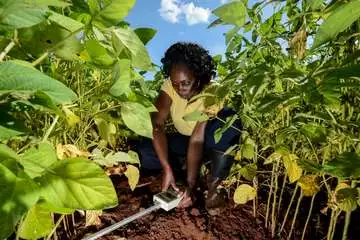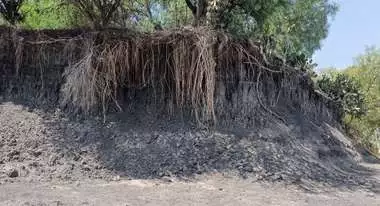Carbon Farming: The potential role for smallholder Farmers and Climate Protection in Africa
Carbon farming projects in Africa promise to contribute to climate change mitigation and reduce the vulnerability of smallholder farmers to climate change, while strengthening food security and reducing poverty. The latter, in part, through new income opportunities from the sale of carbon credits. But what is behind the buzzword ‘carbon farming’?

What is Carbon Farming?
Carbon farming meaning: The term carbon farming has emerged as a new buzzword in the debate on the role of the agricultural sector in combatting climate change. It refers to sustainable agricultural practices that aim to increase the storage of carbon in biomass / trees and soils while reducing greenhouse gas emissions. Examples include agroforestry, intercropping, the cultivation of cover crops, reduced tillage or the application and improved management of organic fertilizers such as manure, compost or mulch. Another important feature of carbon farming is the underlying business model, whereby revenues are generated from trading carbon credits [1], [2].
Some 33 million smallholder farms in Africa play a crucial role in ensuring food security and feeding the world's growing population [3]. However, they face significant challenges, including soil degradation and the multifaceted impacts of climate change. To counteract ongoing soil degradation, sustainable agricultural practices, together with training programs, and supporting policy measures are needed [4].
Switching to more sustainable agricultural practices, for example carbon farming, involves costs. This includes costs for learning new techniques or investments in materials such as seedlings, and new tools or machinery. These costs are often a barrier for smallholder farmers to transition to sustainable agriculture. While smallholders must bear the financial burden on their own, the benefits accrue to many others - particularly through the potential of sustainable agriculture to reduce greenhouse gas emissions and remove carbon from the atmosphere and store it in soils and biomass or trees.
Payments for ecosystem services could help to overcome the gap between individual costs and societal benefits. The voluntary carbon market provides a platform for private investors who are interested in purchasing carbon credits. One carbon credit represents the reduction or storage of one ton of carbon dioxide. Revenues from carbon trading could incentivize a shift to more sustainable agricultural practices and compensate smallholders for their contribution to climate change mitigation.

The importance of agriculture through carbon farming therefore stems from the synergy between ecological objectives - carbon sequestration in ecosystems - and economic objectives.
From climate problem to solution: agriculture in the focus
The agricultural sector is a significant contributor to climate change, as about one third of total greenhouse gas emissions are attributable to food systems [5]. At the same time, the agricultural sector can also be an important part of the solution.
After being neglected in global climate conferences for a long time, the agricultural sector is now receiving increased attention and constitutes the central link in the current discussion on carbon farming. The agricultural sector could serve as part of the solution by promoting emission reduction measures and natural carbon sinks. It is estimated that natural carbon sinks (forests, wetlands, grasslands, and agricultural lands) provide about 37% of the carbon dioxide mitigation needed to limit global warming to 2°C by 2030. A large share of this mitigation potential (about one fifth) is attributed to the agricultural sector [6].
Carbon markets are a source of funding at the nexus of the agricultural sector and climate change mitigation.
Friederike SchillingHowever, to harness the potential of the agricultural sector in climate action, financing is needed. One possible source of funding that leverages the link between the agricultural sector and climate action are carbon markets.
Compliance markets, such as the Clean Development Mechanism (CDM), enable the trading of carbon credits between developing and developed countries to comply with binding climate targets [7]. Although the CDM has methodologies for the agricultural sector, these have limited applicability in the context of smallholder farmers in Africa. Carbon credits can be generated through afforestation and reforestation projects, but carbon storage in soil remains ineligible [8].
Voluntary markets are aimed at organizations that want to offset their greenhouse gas emissions outside of legal requirements, for example to advertise products as ‘climate neutral’ or to achieve voluntary sustainability goals. Voluntary markets offer two main advantages compared to compliance markets. First, they allow projects to generate carbon credits for soil carbon storage, which is particularly important given the potential of agricultural soils. Secondly, voluntary markets offer a wider range of methodologies on which project developers can build carbon farming projects. This has led to carbon farming projects being better represented in the voluntary carbon market [9].
However, carbon farming projects play a minor role compared to other projects in the voluntary carbon market. In 2022, most carbon credits in sub-Saharan Africa were generated for avoided deforestation of forests (58%) and improved cookstoves (22%) [10].
Carbon farming projects in Africa: a growing market
Individual farmers, especially smallholders in Africa, do not engage directly with carbon markets. Private companies or non-governmental organizations are often the ones that develop eligible projects and recruit farmers to store carbon or reduce emissions.
Figure 1 shows carbon farming projects in Africa that are registered in the voluntary carbon market (under Verra and Gold Standard). Agriculture carbon farming projects in Africa have been generating carbon credits from the agricultural sector for about 15 years and the number of new projects is growing steadily. Most projects are in Kenya, South Africa and Uganda [10].

Table 1 introduces three exemplary projects from Eastern Africa [1]:
Project | (1) Boomitra Carbon Farming in East Africa through Soil Enrichment | (2) Lake Naivasha Basin Reforestation Project | (3) Western Kenya Soil Carbon Project |
Country | Kenya, Rwanda, Tanzania and Uganda | Kenya | Kenya |
|
|
|
|
Activities | Implementation of sustainable land management practices | Planting trees on own land: 650 - 1,100 trees per hectare | Implementation of sustainable land management practices and agroforestry
|
|
|
|
|
Project area
| 226,125 hectares
| 1,000 hectares | 32,000 hectares |
Carbon pool | Soil organic carbon | Above- and below-ground biomass
| Soil organic carbon and above- and below-ground biomass
|
Registry and methodology | Verra: VM0042 | Gold Standard: 401.13 AR | Verra: VM0017
|
Verification of carbon storage | Soil sampling combined with modelling (RothC), additional satellite-based estimates | Partial inventory of trees | Model-based: RothC |
[1] Information on the example projects comes from the public project descriptions in the registers of Verra (projects 1 and 3) and Gold Standard (project 2).
Measuring and verifying carbon storage for generating carbon credits
Actors like Verra and Gold Standard play a crucial role in the voluntary carbon market. They develop standards and methodologies to assess and certify climate projects. They also verify whether projects meet the set standards and then issue carbon credits. The stringency of methodologies is important to ensure the confidence of potential investors in the market. Low quality carbon credits could jeopardize market stability [11], which is why scientifically sound methodologies are urgently needed, as the recent debate on carbon credits for avoided deforestation has shown [12].
Quantifying carbon storage in biomass, such as through tree planting in agroforestry systems, is methodologically quite straightforward. Instead of actually measuring carbon storage through cutting and analyzing existing trees, an estimate is made using various parameters. In the Verra and Gold Standard methodologies, carbon storage is first estimated ex-ante using fixed parameters such as growth rates and the proportion of carbon in the biomass, and variable assumptions about the number and type of trees planted. Full or partial inventories of the planted trees are carried out regularly to confirm the project assumptions. Satellite technology can support this. An example of a project that generates carbon credits for setting up agroforestry systems is the Lake Naivasha Basin Reforestation Project (Table 1).
The quantification of soil carbon is methodologically complex. The difficulties arise from the natural heterogeneity of soil, the need to account for large soil volumes and depths, the long timescales for change, the resulting time requirements and cost involved, and the variety of existing soil carbon measurement methods [13]. Available measurement methods fall into one of three categories: Laboratory methods, in-situ measurements using soil scanners, and remote sensing using satellite technology. Especially for projects working with smallholder farmers, quantifying soil carbon storage through soil sampling can be a significant cost – which is one of the disadvantages of carbon farming.
While earlier projects were able to generate carbon credits purely based on models and with the help of activity monitoring, new standards require direct measurement of soil carbon. As laboratory methods are costly and time-consuming, carbon farming projects are testing cheaper in-situ measurements with soil scanners or a combination of satellite technology and laboratory methods. To use these lower-cost methods, however, certifiers expect accurate estimates of the precision of these methods compared to laboratory analyses. The actual potential of these alternatives will therefore only become apparent in the coming years. The Western Kenya Soil Carbon Project and the Boomitra Carbon Farming in East Africa through Soil Enrichment project (Table 1) are examples of carbon farming projects that work with smallholder farmers in Africa and generate carbon credits for storing carbon in the soil.
The drivers of success in carbon farming projects for smallholder farmers
The scientifically sound and cost-efficient quantification of carbon sequestration is crucial to develop carbon markets as a source of financing for climate projects. Methodologies that meet the highest standards of precision in soil carbon measurement are the foundation on which the success of carbon farming projects is built. They are necessary to strengthen the demand for quality carbon credits and to achieve high prices.
Currently, carbon farming projects in Africa often refer to payments to smallholder farmers as "token thank you" or "carbon bonus". This illustrates the current low level of payments but is also intended to show that the improved soil quality and expected yield increases are the incentive, rather than direct payments. Some projects prefer to reinvest the income in training programs and to cover administrative costs [14], [15].
To maximize income opportunities for smallholders, it is crucial to keep administrative costs for project implementation, including those for carbon quantification, low. To reduce costs while increasing the accuracy of carbon sequestration measurements, further research and innovation are needed, particularly in the area of soil carbon measurement as well as innovative approaches in working with smallholder farmers.
Due to the high costs of carbon farming projects and the challenges of measuring carbon changes with many smallholders, the question of the current and future profitability of the projects remains to be answered. Besides overall profitability, other questions arise. Is there a risk that projects will favor larger farms to keep implementation costs lower? What kind of governance structures and regulations are needed to ensure that carbon farming projects are implemented fairly and sustainably? How can carbon farming projects be scaled up to cover larger areas and more smallholders to make a more significant contribution to global emissions reductions?

References
[1] H. Mcdonald et al., “Carbon farming - Making agriculture fit for 2030 ,” Study for the committee on Environment, Public Health and Food Safety (ENVI), Policy Department for Economic, Scientific and Quality of Life Policies, European Parliament, Luxembourg, 2021.
[2] F. Schilling, H. Baumüller, J. Ecuru, and J. von Braun, “Carbon farming in Africa: Opportunities and challenges for engaging smallholder farmers,” ZEF Working Paper, no. 221, 2023, Accessed: Sep. 24, 2023. [Online]. Available: bonndoc.ulb.uni-bonn.de/xmlui/handle/20.500.11811/10771
[3] M. A. Altieri, F. R. Funes-Monzote, and P. Petersen, “Agroecologically efficient agricultural systems for smallholder farmers: contributions to food sovereignty,” Agron Sustain Dev, vol. 32, pp. 1–13, 2012.
[4] R. Lal, “Soil carbon sequestration impacts on global climate change and food security,” Science (1979), vol. 304, no. 5677, pp. 1623–1627, 2004.
[5] M. Crippa, E. Solazzo, D. Guizzardi, F. Monforti-Ferrario, F. N. Tubiello, and A. Leip, “Food systems are responsible for a third of global anthropogenic GHG emissions,” Nat Food, vol. 2, no. 3, pp. 198–209, 2021.
[6] B. W. Griscom et al., “Natural climate solutions,” Proceedings of the National Academy of Sciences, vol. 114, no. 44, pp. 11645–11650, 2017.
[7] UNFCCC, “About CDM.” Accessed: Feb. 10, 2023. [Online]. Available: cdm.unfccc.int/about/index.html
[8] UNFCCC, “Clean Development Mechanism: CDM Methodology Booklet. Thirteenth edition.,” 2021. Accessed: Feb. 10, 2023. [Online]. Available: cdm.unfccc.int/methodologies/documentation/2203/CDM-Methodology-Booklet_fullversion.pdf
[9] K. Benessaiah, “Carbon and livelihoods in Post-Kyoto: Assessing voluntary carbon markets,” Ecological Economics, vol. 77, pp. 1–6, May 2012, doi: 10.1016/J.ECOLECON.2012.02.022.
[10] I. S. So, B. K. Haya, and M. Elias, “Voluntary Registry Offsets Database v7.1.” Berkeley Carbon Trading Project, University of California, Berkeley, 2023. Accessed: Feb. 07, 2023. [Online]. Available: gspp.berkeley.edu/faculty-and-impact/centers/cepp/projects/berkeley-carbon-trading-project/offsets-database
[11] A. A. Jackson Hammond et al., “Implementing the soil enrichment protocol at scale: Opportunities for an agricultural carbon market,” Frontiers in Climate, p. 64, 2021, doi: doi.org/10.3389/fclim.2021.686440.
[12] T. Fischer and H. Knuth, “CO2 Certificates: Phantom Offsets and Carbon Deceit,” Die Zeit, vol. 04, 2023, Accessed: Feb. 08, 2023. [Online]. Available: www.zeit.de/wirtschaft/2023-01/co2-certificates-fraud-emissions-trading-climate-protection-english
[13] P. Smith et al., “How to measure, report and verify soil carbon change to realize the potential of soil carbon sequestration for atmospheric greenhouse gas removal,” Glob Chang Biol, vol. 26, no. 1, pp. 219–241, 2020.
[14] J. Lee, M. Ingalls, J. D. Erickson, and E. Wollenberg, “Bridging organizations in agricultural carbon markets and poverty alleviation: An analysis of pro-Poor carbon market projects in East Africa,” Global Environmental Change, vol. 39, pp. 98–107, Jul. 2016, doi: 10.1016/J.GLOENVCHA.2016.04.015.
[15] Y. Tamba et al., “A review of the participation of smallholder farmers in land-based carbon payment schemes,” TMG and ICRAF Working Paper, Nov. 2021, doi: 10.35435/2.2021.4.




